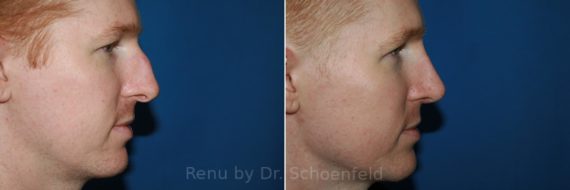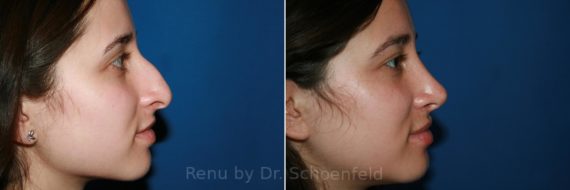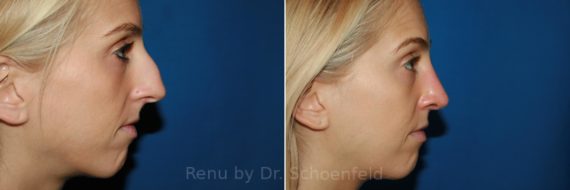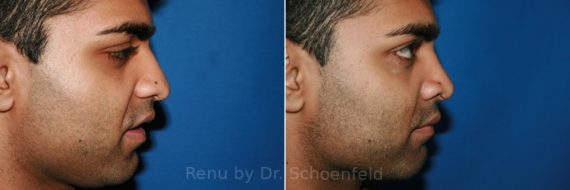The decision to undergo a rhinoplasty is a very personal one. In my practice I love to hear the motivation behind my prospective patients for seeking to have rhinoplasty surgery. Some of these stories are quite powerful. The stories vary depending upon the age of the patient who is considering rhinoplasty. One of my favorite reasons is because the individual had never really been happy or comfortable with the appearance of their nose but they were too self conscious and concerned with what others would say if they had rhinoplasty surgery. When they come to see me and share that they have come to the conclusion that it is their life and no longer are concerned with the opinion of others and simply want to do their rhinoplasty for themselves I am thrilled for them. I realize that I am going to be able to participate in a small but meaningful part of their life’s journey and take this responsibility very seriously. So what do people want to know about rhinoplasty?
- What is Rhinoplasty?
- Am I a candidate for a nose job?
- Your Rhinoplasty Consultation in Washington DC
- The Rhinoplasty Procedure
- How much does a nose job cost?
- What is the perfect nose?
- Recovering from a Rhinoplasty Procedure
- What is the difference between an open rhinoplasty versus closed rhinoplasty?
- What happens if I don't like my nose?
- How do I prepare for my rhinoplasty?
- FAQs about the Nose Job Procedure
What is Rhinoplasty?
Rhinoplasty surgery, often known as a “nose job,” is an ancient plastic surgery procedure that has been performed for thousands of years. It is used to reshape and resize the nose to look more natural and proportional to the other facial features. Some of the most common requests from rhinoplasty patients include removing a dorsal “hump” from the bridge of the nose, straightening a crooked nose, or reducing the overall size of the nose. Other patients have trouble breathing, often due to a deviated septum, which is caused by crookedness in the nasal septum (the wall separating the nasal passages). Rhinoplasty can improve or correct this issue, which can result in better breathing for the patient. Overall, rhinoplasty is an extremely versatile procedure that can produce incredible results when performed by an expert.
Rhinoplasty Surgery Before & After Photos in Washington DC
* Each patient is unique and individual results may vary.
Am I a candidate for a nose job?
Deciding on rhinoplasty is deeply personal. Concerns like nose size, crookedness, or shape drive individuals to explore surgery. Consultations involve discussing desired outcomes and establishing realistic goals. Structural assessments and computer imaging aid in visualization. Age is a factor; while few are too old, maturity is essential for younger patients. Men should typically be 16 or older, while physically mature and informed women can consider rhinoplasty at 14. Over time, societal acceptance has led to increased requests from older individuals seeking nose improvements they’ve long desired but previously felt unable to pursue.
Common reasons for rhinoplasty:
- Nose size: Some individuals feel their nose is too large or disproportionate to their facial features.
- Crooked nose: Deviation or asymmetry in the nasal bridge or septum can lead to aesthetic concerns.
- Tip shape: Desire for refinement or reshaping of the nasal tip to achieve a more defined or balanced appearance.
- Dorsal hump: Removal or reduction of a prominent bump or hump on the nasal bridge.
- Nostril size/shape: Correction of oversized, asymmetrical, or misshapen nostrils.
- Breathing difficulties: Addressing structural issues such as a deviated septum that impairs nasal airflow.
- Previous injury: Repairing or reconstructing the nose after trauma or injury.
- Congenital defects: Correcting birth defects or abnormalities affecting nasal appearance or function.
- Self-esteem: Improving self-confidence and overall satisfaction with facial aesthetics.
- Ethnic considerations: Enhancing or preserving ethnic features while addressing specific cosmetic concerns.
Your Rhinoplasty Consultation in Washington DC
If you are considering moving forward with rhinoplasty Washington DC, then your next step is to schedule an initial consultation with an expert plastic surgeon like Dr. Schoenfeld to discuss your goals for the procedure and find out whether or not you are a good candidate for rhinoplasty. During your consultation, you’ll have the opportunity to get to know Dr. Schoenfeld and learn more about the rhinoplasty process. He will generate images of your nose and enhance them to give you an idea of the types of changes you might expect from the nasal surgery. You’ll be able to ask any questions you may have about the procedure or about Dr. Schoenfeld and Renu. Your initial consultation is a valuable learning experience, so come prepared to discuss your goals and ask lots of questions. Consider taking a look at some rhinoplasty before and after photos before you come in so you can identify what you do and don’t want from the nasal surgery.
The Rhinoplasty Procedure
It is typical to perform rhinoplasty under general anesthesia on an outpatient basis, as it is a fairly invasive procedure. Depending on the extent of the nasal surgery, the procedure will take between one to three hours to complete.
Nose surgery can be performed using an “open” or “closed” technique. The open technique, which is the most popular, involves the surgeon making a small incision between the nostrils in order to lift up the skin and have unobstructed access to the tissues beneath. The closed method involves incisions made inside the nose, resulting in no visible scars but less visibility and a decreased ability to manipulate the tissues. You and your surgeon will discuss the technique to be used prior to the procedure. Once the incisions have been made, the surgeon will graft and reposition cartilage to reshape the nose and remove bony material if necessary, while ensuring the nose maintains function and structural integrity.
Once the incisions are closed, a dressing will be placed on the nose and the patient can return home shortly afterward to begin the healing process.
Real Rhinoplasty Patients
How much does a nose job cost?
The price of a primary rhinoplasty (nose job) will vary depending upon several factors. The location of the practice, the experience of the surgeon and the complexity of the nose to name a few. Our surgical fee for rhinoplasty cost starts at around $11,500. There are other associate costs for rhinoplasty that includes facility fees and anesthesia fees. If you are having functional work, such as septoplasty, inferior turbinoplasty, or repair of nasal valves performed at the same time we do accept insurance coverage for these procedures if your insurance will cover the procedures. Insurance coverage for functional issues performed at the same time will significantly decrease the cost of anesthesia and facility fees for your rhinoplasty but will not cover any of the rhinoplasty surgeon fees you will be quoted.
What is the perfect nose?
Quite simply, the perfect nose is the nose that will look best on your face not just in the short term, but for many years to come. My philosophy is that no two faces are alike, and although noses can be similar in appearance, every nose I create is unique to that individual. I do not try to put a “Dr. Schoenfeld” nose on every patient I treat. I put the best nose that you can have on your face. I also see myself as a bit of a nose architect. In other words, I want you to bring me your “plans” for your ideal nose. I will build that nose for you but probably discuss some subtle changes to the nose that would make he nose look more appropriate for your face. I think the perfect nose is a nose that absolutely does not look “operated” or “done”. The nose should not draw attention but rather enhance your other facial features. I also think the perfect nose is one that helps to create the best you that you can be.
Recovering from a Rhinoplasty Procedure
Recovering from a rhinoplasty is not as daunting as it may seem! We believe that being informed and prepared is key to a smooth and stress-free journey back to feeling like yourself. In the first few days, you might feel some pressure and discomfort, but don’t worry—we’ll provide you with a personalized pain management plan. We’ve also put together a detailed post-operative guide for you to reference, ensuring you know exactly what to expect and how to care for yourself for the best outcome possible.
As you start to move around, you’ll notice that even small activities can help you feel more like your normal self and reduce any bloating or discomfort from medication. And let’s not forget about swelling and bruising—totally normal! We’ve got some tips and tricks, like pineapple extracts and frozen peas, to help minimize these effects and speed up your recovery.
Remember, it’s a gradual process, but we’re here with you every step of the way. Whether it’s adjusting your activity level or making sure you’re comfortable, we’ll tailor your recovery plan to fit your needs. So take it easy, listen to your body, and know that we’re here to support you on your journey to looking and feeling your best!
What is the difference between an open rhinoplasty versus closed rhinoplasty?
I have been performing rhinoplasty surgery for over 20 years. During this period of time I have performed both open and closed rhinoplasty procedures. I would say that the majority of primary rhinoplasty procedures that I perform, especially involving complicated nasal tip work are open and almost all revision rhinoplasty is performed open. The difference between the two procedures is essentially one small incision underneath the nose on the portion of skin between the two nostrils that is called the columella. This incision is closed meticulously and heals imperceptibly. A poor scar is not acceptable and unless there is extenuating circumstances leading to scarring, this is not usually an issue. I feel that the advantages to using this approach far outweighs any potential disadvantages of this surgical approach. A lot of discussion surrounding open versus closed rhinoplasty is based on here say and not facts. Post operative pain, swelling, edema, and bruising are identical with both surgical approaches. There is definitely going to be some tip numbness following the open approach but there is also potential for numbness of the nasal tip following the closed approach. The surgical access that the open approach affords me is unparalleled especially in complicated nasal tip work. I still perform about 20% of primary rhinoplasty using the closed approach. I teach my residents both the open and closed approach, but my feeling is that short term tip numbness associated with the open approach is a very small inconvenience in exchange for a long term beautiful surgical result in complex cases.
What happens if I don’t like my nose?
You’ll adore your nose! While primary rhinoplasty has a 7% revision rate, it’s even higher for revision surgeries. Factors like surgical precision, healing, and expectations influence this. Opting for an experienced surgeon reduces risks. With over 20 years in rhinoplasty, I assure you won’t look “botched”. Unrealistic expectations, often fueled by social media, can lead to dissatisfaction. Using computer imaging helps set realistic goals. Post-op, minor adjustments may be needed, but major revisions require patience. Remember, perfection takes time and open communication. Your satisfaction is my priority!
How do I prepare for my rhinoplasty?
The best way to get yourself prepared for your rhinoplasty is understanding that you are going to be having surgery and that surgery is going to positively change the appearance and perhaps the function of your nose. Having surgery is a commitment both mental and physical. You should be excited for your surgery and being a little stressed or worried prior to surgery is a normal response. Educating yourself and asking either me or my office questions that you may have prior to your surgery can help reduce your anxiety. You can be confident that the discussions that we had in consultation with regard to what you would like your nose to look like are very meticulously documented in your chart and photos are available to me during surgery for reference.
Eating healthy and avoiding inflammatory foods such as excess sugar, high fructose corn syrup, trans fatty acids, excess carbohydrates, and alcohol prior to your surgery will help with the healing process. Increasing your intake of pineapple, which contains bromelain, a powerful natural anti inflammatory, both before and after surgery will really help with the healing process by reducing swelling and bruising.
FAQs about the Nose Job Procedure
Swelling can persist for many months following rhinoplasty since the tissues in the nose heal slowly. The swelling will go down gradually over the first few months, with much of it subsiding within the first few weeks. Residual swelling may remain for 6-12 months following surgery, so results are not considered final until that time.
If you live near Chevy Chase, MD, RENU by Dr. Schoenfeld offers rhinoplasty among its services and is conveniently located at 5454 Wisconsin Ave #1625, Chevy Chase, MD 20815.
While it is possible to get a second rhinoplasty (known as a revision rhinoplasty), it is best to avoid this by choosing a qualified and experienced surgeon. Rhinoplasty surgery is extremely difficult the first time, and it becomes even more difficult the second time. Careful planning and realistic expectations will go a long way toward ensuring you are happy with your results. Nose cosmetic surgery doesn’t always go as planned, unfortunately, but if you choose your surgeon wisely, you are likely to get a beautiful result.
Choosing to undergo a nose job procedure is a big decision, and you will have to make the choice about when the time is right yourself—do not let anyone pressure you. If you’re not sure yet, do some more research, consult with a plastic surgeon, and make sure it’s something you really want before you go through with it. Your rhinoplasty surgery in Washington DC produces permanent results, so don’t take the decision lightly!
Though all surgery carries some risk, an experienced rhinoplasty surgeon will be able to minimize the risks of the procedure, which can include:
• Excessive bleeding
• Scarring
• Infection
• Asymmetry
• Breathing problems
• Poor aesthetic outcome
Dr. Schoenfeld has over 20 years of experience he and will work closely with you to minimize your risk as much as possible.
Open rhinoplasty does involve an external incision, but this typically heals very well and eventually no one should be able to notice it unless you point it out. Closed rhinoplasty is made through incisions hidden within the nose, so these should be invisible. There is always a small scarring risk in surgery, but it’s minimal for rhinoplasty Washington DC.
Rhinoplasty Surgery Related Articles
- Choosing Between Surgical and Non-Surgical Rhinoplasty
- What happens in the post-operative visit following a rhinoplasty?
- Are you wondering what to expect after a Rhinoplasty?
- Will my nose look like all the other rhinoplasty patients.
- I feel like my nose droops down in between the nostrils, can this be leveled off?
Choose an Expert Plastic Rhinoplasty Surgeon in Washington DC
Because rhinoplasty is an extremely difficult, complex, and custom procedure, it should only be performed by an expert plastic surgeon. Dr. Schoenfeld is double board certified in Otolaryngology/Head and Neck Surgery, and Facial Plastic and Reconstructive Surgery. He has the skill and experience to help you achieve beautiful, natural-looking results from rhinoplasty. If you would like to learn about rhinoplasty at Renu in Washington DC, Chevy Chase, and Maryland, call our office at 301-652-7368 to schedule your consultation with Dr. Schoenfeld.








